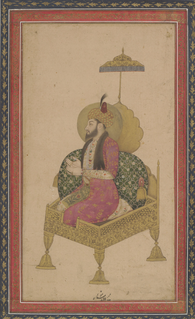Related Research Articles

The Zengid or Zangid dynasty was a Muslim dynasty of Oghuz Turk origin, which ruled parts of the Levant and Upper Mesopotamia on behalf of the Seljuk Empire. The dynasty was founded by Imad ad-Din Zengi.

Shams ud-Din Iltutmish, was the third of the Mamluk kings who ruled the former Ghurid territories in northern India. He was the first Muslim sovereign to rule from Delhi, and is thus considered the effective founder of the Delhi Sultanate.
Qutb al-Din Aibak was a general of the Ghurid king Mu'izz ad-Din Muhammad Ghori. He was in-charge of the Ghurid territories in northern India, and after Mu'izz ad-Din's death, he became the ruler of an independent kingdom that evolved into the Delhi Sultanate ruled by the Mamluk dynasty.

The Muzaffarid dynasty was a Persian dynasty which came to power in Iran following the breakup of the Ilkhanate in the 14th century. At their zenith, they ruled a kingdom comprising Iranian Azerbaijan, Central Persia, and Persian Iraq.

Mirza Jalal-ud-din Miran Shah Beg, commonly known as Miran Shah, was a son of the Central Asian conqueror Timur, founder of the Timurid Empire.

The Kart dynasty, also known as the Kartids, was a Sunni Muslim dynasty of Tajik origin closely related to the Ghurids, that ruled over a large part of Khorasan during the 13th and 14th centuries. Ruling from their capital at Herat and central Khorasan in the Bamyan, they were at first subordinates of Sultan Abul-Fateh Ghiyāṣ-ud-din Muhammad bin Sām, Sultan of the Ghurid Empire, of whom they were related, and then as vassal princes within the Mongol Empire. Upon the fragmentation of the Ilkhanate in 1335, Mu'izz-uddin Husayn ibn Ghiyath-uddin worked to expand his principality. The death of Husayn b. Ghiyath-uddin in 1370 and the invasion of Timur in 1381, ended the Kart dynasty's ambitions.
Shams al-Din 'Ali ibn Mas'ud ibn Khalaf ibn Mihraban was the first Mihrabanid malik of Sistan. He ruled from 1236 until his death.
Qutb al-Din Muhammad was the Mihrabanid malik of Sistan from 1330 until his death. He was the son of Rukn al-Din Mahmud.
Taj al-Din was the Mihrabanid malik of Sistan from 1346 until 1350. He was the son of Qutb al-Din Muhammad.
Jalal al-Din Mahmud was the Mihrabanid malik of Sistan from 1350 until his death. He was the son of Rukn al-Din Mahmud.
Izz al-Din was the Mihrabanid malik of Sistan from 1352 until 1380. He was the son of Rukn al-Din Mahmud.

The Mihrabanid dynasty was a Muslim dynasty that ruled Sistan from 1236 until the mid-16th century. It is the third indigenous Muslim dynasty of Sistan, having been preceded by the Saffarid and Nasrid dynasties.
Taj al-Din Shah-i Shahan Abu'l Fath or Shah-i-Shahan of Sistan was the Mihrabanid malik of Sistan from 1383 until his death. He was the son of Mas'ud Shihna.
Qutb al-Din Muhammad was the Mihrabanid malik of Sistan from 1403 until his death. He was the son of Shams al-Din Shah 'Ali.
Nasir al-Din Muhammad was the Mihrabanid malik of Sistan from 1261 until his death. He was the son of Mubariz al-Din Abu'l-Fath ibn Mas'ud.
Shams al-Din 'Ali was the Mihrabanid malik of Sistan from 1419 until his death. He was the son of Qutb al-Din Muhammad.
Shams al-Din Muhammad was the Mihrabanid malik of Sistan from 1480 until around the end of the 15th century. He was the eldest son of Nizam al-Din Yahya.
Sultan Mahmud was the last Mihrabanid malik of Sistan, from c. 1495 until c. 1537.
Qutb al-Din or ad-Din is a masculine given name composed of the elements Qutb and al-Din. Notable bearers of the name include:

Ghiyath al-Din Muhammad, was sultan of the Ghurid dynasty from 1163 to 1202. During his reign, the Ghurid dynasty became a world power, which stretched from Gorgan to Bengal.
References
- Bosworth, C.E. The History of the Saffarids of Sistan and the Maliks of Nimruz (247/861 to 949/1542-3). Costa Mesa, California: Mazda Publishers, 1994.
| Preceded by Izz al-Din ibn Rukn al-Din Mahmud | Mihrabanid malik 1380–1383 | Succeeded by Taj al-Din Shah-i Shahan |